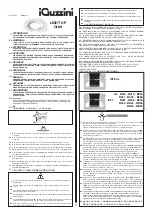
FTS 370d/w/r
Revision 10 – 1/09/2015
15
Wiring
Typical E1/D1 & E2/D2 component location
diagrams are shown in Figures 2-16 and 2-
17.
A D1/D2 system wiring diagram is
shown in Figure 2-19 and an E1/E2 wiring
diagram is shown in Figure 2-20. A typical
Catenary component location diagram is
shown in Figure 2-18 with a wiring diagram
shown in Figure 2-21. Installation notes for
system types shown in Figures 2-19 - 2-21
are located after each figure. Installation
instructions concerning MKR 370 L-810
marker fixtures are supplied with the marker
kit.
The system installation diagrams
provided in this manual may not contain all
of the required wiring information for
installation at your site.
Important!
If
installation
drawings
prepared
specifically
for
your
site
disagree with information provided in this
manual, the site installation drawings
should take precedence. Consult any site-
specific
installation
wiring
diagrams
supplied with your equipment.
Flash Technology wiring diagrams define
only
minimum
requirements
recommended for satisfactory equipment
operation. It is the responsibility of the
installer to comply with all applicable
electrical codes.
All communication wiring should have an
insulation rating of 300 volts minimum. All
power wiring should have an insulation
rating of 600 volts.
Input power wiring
must be sized to satisfy the load demand of
all connected SC 370 systems.
Read the
notes on the installation wiring diagrams
supplied both in this manual and with the
equipment.
I
nput Power
Input power conductor size depends on the
service voltage, distance from the source
and the number of units installed in the
system. Assume 340 VA per SC 370 in the
system. Connect the input power to L1, L2
(AC units) or
+
,
-
(DC units) and Ground
terminals of TB1 located in the lower right
of the cabinet.
Important!
For proper operation and
optimal protection from Lighting and EMI,
ensure that Earth Ground is wired to the
Ground (Green) Terminal.
Photodiode Wiring
The photodiode must be connected to the SC
370 designated as System 1.
The photodiode
connections are located on PCB2 at terminal
block P6.
The white wire is connected to the
terminal marked “WHT” and the black wire
is connected to the terminal marked “BLK”.
Only one photodiode is required per system.
It may be located any practical distance
from System 1.
The standard photodiode
(Part # 1855512) is supplied with 20’ of
cable. Photodiodes with cable lengths up to
75’ are available. Also, the cable may be
spliced to provide additional length.
The
recommended minimum wire gauge is 16
AWG if additional length is necessary.
Photodiode Mounting
The photodiode, also referred to as PHD
512, is shown in Figure 2-1 and mounting
and outline dimensions are shown in Figure
2-11. The photodiode uses a male 1/2” NPT
for mounting. Use the following guidelines
to mount the photodiode:
Locate the photodiode where it has an
unobstructed view of the polar sky.
It must not view direct or reflected
artificial light.
The photodiode may be mounted at the
top end of a vertical length of rigid
conduit or to the optional Antenna
Mounting Bracket kit (P/N 1905355).
It should not be mounted underneath
the
controller
where
it
could
be
shadowed.
Summary of Contents for VANGUARD FTS 370d
Page 2: ......
Page 36: ...24 Revision 10 1 09 2015 FTS 370d w r Figure 2 5 Marker Interface Wiring ...
Page 54: ...42 Revision 10 1 09 2015 FTS 370d w r Figure 2 21 Typical Catenary System Wiring Diagram ...
Page 94: ...This page intentionally left blank ...
Page 96: ...84 Revision 10 1 09 2015 FTS 370d w r Figure 6 1 SC 370 AC Component Locations ...
















































